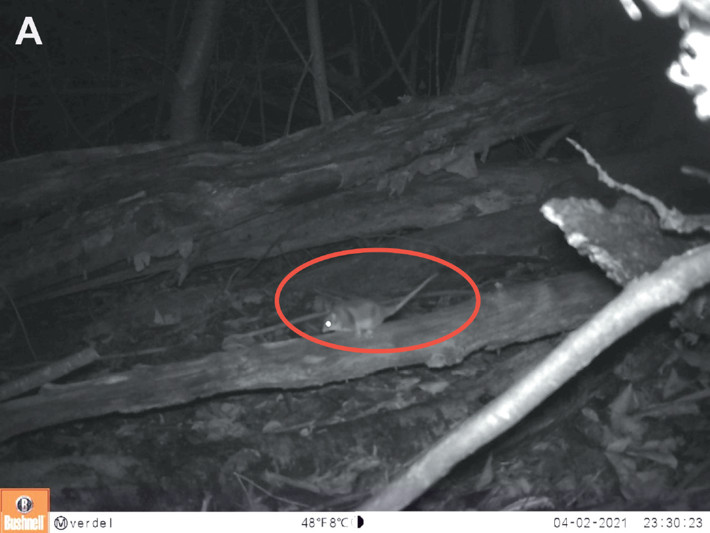Nuevos registros de Dromiciops gliroides (Thomas, 1894) en el límite sur de su distribución en Argentina
DOI:
https://doi.org/10.31687/SaremNMS22.8.1Palabras clave:
Argentina, distribución, Dromiciops, límite sur, registroResumen
El género Dromiciops presenta una distribución restringida a zonas de bosques templado lluviosos del centro y sur de Argentina y Chile. Sin embargo, hacia los límites norte y sur de su distribución se han obtenido nuevos registros en los últimos años. En este trabajo reportamos nuevos registros en el Parque Nacional Los Alerces (noroeste del Chubut, Argentina), uno de los cuales representa el más austral de la especie Dromiciops gliroides obtenido hasta el momento en Argentina.
Citas
Amico, G. C., & M. A. Aizen. 2000. Mistletoe seed dispersal by a marsupial. Nature 408:929–930. https://doi.org/10.1038/35050170.
Amico, G. C., M. A. Rodríguez-Cabal, & M. A. Aizen. 2009. The potential key seed-dispersing role of the arboreal marsupial Dromiciops gliroides. Acta Oecologica 35:8–13. https://doi.org/10.1016/j.actao.2008.07.003.
Celis-Diez, J. L., et al. 2012. Population abundance, natural history, and habitat use by the arboreal marsupial Dromiciops gliroides in rural Chiloé Island, Chile. Journal of Mammalogy 93:134–148. https://doi.org/10.1644/10-MAMM-A-406.1.
Cortez Parra, C. R., & L. G. Torres-Fuentes. 2021. Presencia de Dromiciops (Microbiotheriidae) en un remanente de bosque esclerófilo mediterráneo del Santuario de la Naturaleza Península de Hualpén, Chile. Gayana 85:146–152. http://dx.doi.org/10.4067/S0717-65382021000200146.
D'Elía, G., N. Hurtado, & A. D'Anatro. 2016. Alpha taxonomy of Dromiciops (Microbiotheriidae) with the description of 2 new species of monito del monte. Journal of Mammalogy 97:1136–1152. https://doi.org/10.1093/jmammal/gyw068.
Gurovich, Y., H. J. Stannard, & J. M. Old. 2015. The presence of the marsupial Dromiciops gliroides in Parque Nacional Los Alerces, Chubut, Southern Argentina, after the synchronous maturation and flowering of native bamboo and subsequent rodent irruption. Revista Chilena de Historia Natural 88:17. http://dx.doi.org/10.1186/S40693-015-0047-1.
Hershkovitz, P. 1999. Dromiciops gliroides Thomas, 1894, last of the Microbiotheria (Marsupialia), with a review of the family Microbiotheriidae. Fieldiana Zoology 93:1–60.
Himes, C. M., M. H. Gallardo, & G.J. Kenagy. 2008. Historical biogeography and postglacial recolonization of South American temperate rain forest by the relictual marsupial Dromiciops gliroides. Journal of Biogeography 35:1415–1424. https://doi.org/10.1111/j.1365-2699.2008.01895.x.
Jiménez, J., & R. Rageot. 1979. Notas sobre la biología del «monito del monte», Dromiciops australis Philippi 1893. Anales del Museo de Historia Natural de Valparaíso 12:83–88.
Martin, G. M. 2010. Geographic distribution and historical occurrence of Dromiciops gliroides Thomas (Metatheria: Microbiotheria). Journal of Mammalogy 91:1025–1035. https://doi.org/10.1644/09-MAMM-A-347.1.
Martin, G. M. 2018. Variability and variation in Dromiciops Thomas, 1894 (Marsupialia, Microbiotheria, Microbiotheriidae). Journal of Mammalogy 99:159–173. https://doi.org/10.1093/jmammal/gyx175.
Martin, G. M. 2019. Dromiciops gliroides. Categorización 2019 de los mamíferos de Argentina según su riesgo de extinción. Lista Roja de los mamíferos de Argentina. (SAyDS–SAREM, eds.). https://doi.org/10.31687/SaremLR.19.001.
Mejías, C., et al. 2021. Natural history of the relict marsupial Monito del Monte at the most extreme altitudinal and latitudinal location. Ecosphere 12:e03577. https://doi.org/10.1002/ecs2.3577.
Mitchell, K. J., et al. 2014. Molecular phylogeny, biogeography, and habitat preference evolution of marsupials. Molecular Biology and Evolution 31:2322–2330. https://doi.org/10.1093/molbev/msu176.
Oda, E., G. B. Rodríguez Gómez, F. E. Fontúrbel, M. Soto-Gamboa, & R. F. Nespolo. 2019. Southernmost records of Dromiciops gliroides: extending its distribution beyond the Valdivian rainforest. Gayana 83:145–149. http://dx.doi.org/10.4067/S0717-65382019000200145.
Palma, R. E., & A. E. Spotorno. 1999. Molecular systematics of marsupials based on the rRNA 12S mitochondrial gene: the phylogeny of Didelphimorphia and of the living fossil microbiotheriid Dromiciops gliroides Thomas. Molecular Phylogenetics and Evolution 13:525–535. https://doi.org/10.1006/mpev.1999.0678.
Patterson, B. D., & M. Rogers. 2007. Order Microbiotheria Ameghino, 1889. Mammals of South America, Vol. 1: Marsupials, Xenarthrans, Shrews, and Bats (A. L. Gardner, ed.). University of Chicago Press, Chicago, Illinois.
Quintero-Galvis, J. F., et al. 2021. The Biogeography of Dromiciops in Southern South America: middle Miocene transgressions, speciation and associations with Nothofagus. Molecular Phylogenetics and Evolution 163:107234. https://doi.org/10.1016/j.ympev.2021.107234.
Quintero-Galvis, J. F., P. Saenz-Agudelo, G. C. Amico, S. Vazquez, A. B. A. Shafer, & R. F. Nespolo. 2022. Genomic diversity and demographic history of the Dromiciops genus (Marsupialia: Microbiotheriidae). Molecular Phylogenetics and Evolution 168:107405. https://doi.org/10.1016/j.ympev.2022.107405.
Salazar, D. A., & F. E. Fontúrbel. 2016. Beyond habitat structure: Landscape heterogeneity explains the monito del monte (Dromiciops gliroides) occurrence and behavior at habitats dominated by exotic trees. Integrative Zoology 11:413–421. https://doi.org/10.1111/1749-4877.12198.
Suárez-Villota, E. Y., C. A. Quercia, J. J. Nuñez, M. H. Gallardo, C. M. Himes, & G. Kenagy. 2018. Monotypic status of the South American relictual marsupial Dromiciops gliroides (Microbiotheria). Journal of Mammalogy 99:803–812. https://doi.org/10.1093/jmammal/gyy073.
Uribe, S. V., R. G. Chiappe, & C. F. Estades. 2017. Persistence of Dromiciops gliroides in landscapes dominated by Pinus radiata plantations. Revista Chilena de Historia Natural 90:2. https://doi.org/10.1186/s40693-017-0065-2.
Valladares-Gómez, A., J. L. Celis-Diez, R. E. Palma, & G. S. Manríquez. 2017. Cranial morphological variation of Dromiciops gliroides (Microbiotheria) along its geographical distribution in south-central Chile: a three-dimensional analysis. Mammalian Biology 87:107–117. https://doi.org/10.1016/j.mambio.2017.07.003.
Vazquez, M. S., M. A. Rodriguez-Cabal, & G. C. Amico. 2022. The forest gardener: A marsupial with a key seed-dispersing role in the Patagonian temperate forest. Ecological Research 36:270–283. https://doi.org/10.1111/1440-1703.12289.
Vazquez, M. S., M. A. Rodríguez-Cabal, D. V. Gonzalez, G. S. Pacheco, & G. C. Amico. 2018. Different nest predator guild associated with egg size in the Patagonian temperate forest. Bird Study 65:478–483. https://doi.org/10.1080/00063657.2018.1555572.
Vazquez, M. S., D. Viviani, W. Mora, M. Aubone, & G. C. Amico. 2021b. Nuevos registros de ocurrencia extienden la distribución norte de Dromiciops (Thomas, 1894) en Argentina. Notas Sobre Mamíferos Sudamericanos 3:e21.11.2. http://doi.org/10.31687/saremNMS.21.11.2.
Vazquez, M. S., L. B. Zamora-Nasca, M. A. Rodríguez-Cabal & G. C. Amico. 2021a. Interactive effects of habitat attributes and predator identity explain avian nest predation patterns. Emu – Austral Ornithology 121:250–260. https://doi.org/10.1080/01584197.2021.1928519.

Descargas
Publicado
Cómo citar
Número
Sección
Licencia
Derechos de autor 2022 Matias Berrondo, Susana Bravo

Esta obra está bajo una licencia internacional Creative Commons Atribución-NoComercial 4.0.

